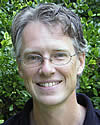 David A.D. Evans |
2015 George P. Woollard Award
Presented to David A.D. Evans
Citation by Samantha Hansen and Joseph L. Kirschvink
For bolstering the geocentric axial dipole (GAD) hypothesis by means of evaporite paleolatitudes over geologic time, for establishing the tropical bias of pre-Ediacaran glaciations, for paleomagnetically defensible reconstructions of pre-Pangean supercontinents, and for conceptualizing geodynamic connections between episodic supercontinents, transient mantle superswells and true polar wander—all achieved with exemplary scholarship, rigor and humility.
 2015 George P. Woollard Award — Response by David A.D. Evans
2015 George P. Woollard Award — Response by David A.D. Evans
Thank you, Joe, and to the Woollard Award committee for giving me this honor—and quite an honor it is to me. I’m really delighted to be recognized for research at the boundary between geology and geophysics. But first and foremost I want to express the deepest gratitude to my wife Lely, her mother Alice, and my children: for putting up with all of my absences from home on field trips and conferences, my somewhat ridiculous commitment to the paleomagnetic laboratory, and too many of my home hours in front of the laptop, setting a bad example for the kids.
My passion for geology and geophysics was courageously fostered by my parents, who knew very little about what I was getting into, but who were supportive all the way. In my public secondary schools, the math and science teachers who most greatly influenced me included Joe Georgeson, David Johnson, Dan Knoebel, and Doug Cooksey—I know that this audience won’t recognize their names, but I would like to recognize them, and all the pre-college school teachers who work so hard to inspire so many children, but too rarely are able to receive gratitude such as this.
I’m fortunate to be able to work daily with those who nurtured the start of my geosciences career in college, especially Brian Skinner, Jay Ague, and Mark Brandon. My geology field camp with University of Wisconsin-Oshkosh, and the Summer of Applied Geophysical Experience (SAGE) field camp in New Mexico, were both incredibly positive experiences. In graduate school, Joe Kirschvink taught me many, many things, but most importantly to give “nutty” ideas a fair chance; Brian Wernicke and Joann Stock helped steer me away from intellectual dead-ends; Nic Beukes and John Grotzinger were role models for soft-spoken humility accompanying excellent science; and Paul Hoffman continuously raised the bar on what I thought might be possible in testing lofty intellectual concepts with fierce academic rigor. Now, long after my own student days, I get to enjoy the camaraderie and hard work of my own students and postdocs, for which I am deeply grateful.
My paleomagnetic and tectonic collaborators of recent years have influenced me in too many ways to squeeze into this brief presentation, but I express my thanks to you all with every citation in my papers. The legacy of Chris Powell’s Tectonics Special Research Centre, where I did my postdoctoral work in Western Australia, lives strong in our community, long after he was prematurely taken away from us; and with each of my own advances in Precambrian supercontinent reconstructions I feel as if I’m merely fulfilling his mission. Similarly, just about any of my paleomagnetic “discoveries” seems to have been presaged decades ago by Ted Irving, also recently departed.
I’m optimistic that the field of paleomagnetism, born as we know it in the 1950s, has outlasted its growing pains of the 1980s and is by now fully matured into a science that touches nearly every major topic of the Earth system. I’m pleased to watch the next generation of paleomagnetists applying both sound geological concepts and robust geophysical approaches to unlock some of the grandest secrets of Earth history and processes, using tiny iron-bearing minerals as the keys. We have many great advances yet to make!
In closing, I give thanks again to my generous nominators, to the George P. Woollard Award committee, and to the Geological Society of America, for giving me this opportunity to represent my community of global tectonicians and paleomagnetists: it’s been a truly enjoyable journey with you all thus far, and I am thrilled at the prospect of continuing our discoveries together, along the fruitful interface between geology and geophysics.
